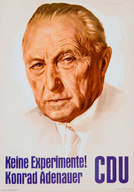
Unternavigation
Chancellor Adenauer himself initiated the pension reform of 1957. According to official proclamations, it sought to establish a new ‘intergenerational contract’ and trigger a process of integration in the young republic. The reform was also aimed at solving the problems caused by the transfer of former social insurance practices into the post-war order.
Despite various attempts at comprehensive basic provision in line with the Beveridge plan, Bismarck’s system of social insurance that was differentiated benefits among categories of policyholders was retained after the Second World War. Following currency reform in 1948, the system was selectively adjusted to include the reintroduction of certain elements of self-administration and the granting of pension supplements. Soon, however, survivor, widow and orphan pensions could no longer keep pace with the rising wages of the post-war boom. In 1955, a report indicated that old age pensions only covered 30 percent of the average wage and many pensioners were living on the breadline.
Adenauer pushed through the pension reform despite opposition from his finance and economy ministers, who were particularly fearful of increasing inflation. On the one hand, the reform included a shift from funded to pay-as-you-go pensions, a system similar to the one introduced for the Swiss old age and survivors’ insurance (AHV) in 1947. Consequently, social insurance disbursed pension benefits financed by payroll contributions paid by future pension recipients rather than by the investment returns of pension reserves. Moreover, the reform provided for ‘dynamic pensions’ that were to be continually adjusted according to general price and wage indices. For German pensioners, this entailed an immediate pension increase of 60 to 70 percent. This enabled them to receive a share of the postwar ‘economic miracle’.
Literatur / Bibliographie / Bibliografia / References: Schulz Günther (ed.) (2005), 1949–1957: Bundesrepublik Deutschland. Bewältigung der Kriegsfolgen, Rückkehr zur sozialpolitischen Normalität (Geschichte der Sozialpolitik in Deutschland seit 1945, Band 3), Baden-Baden; Metzler Gabriele (2003): Der deutsche Sozialstaat. Vom bismarckschen Erfolgsmodell zum Pflegefall, Stuttgart; Stolleis Michael (2003), Geschichte des Sozialrechts in Deutschland, Stuttgart.
(12/2014)




